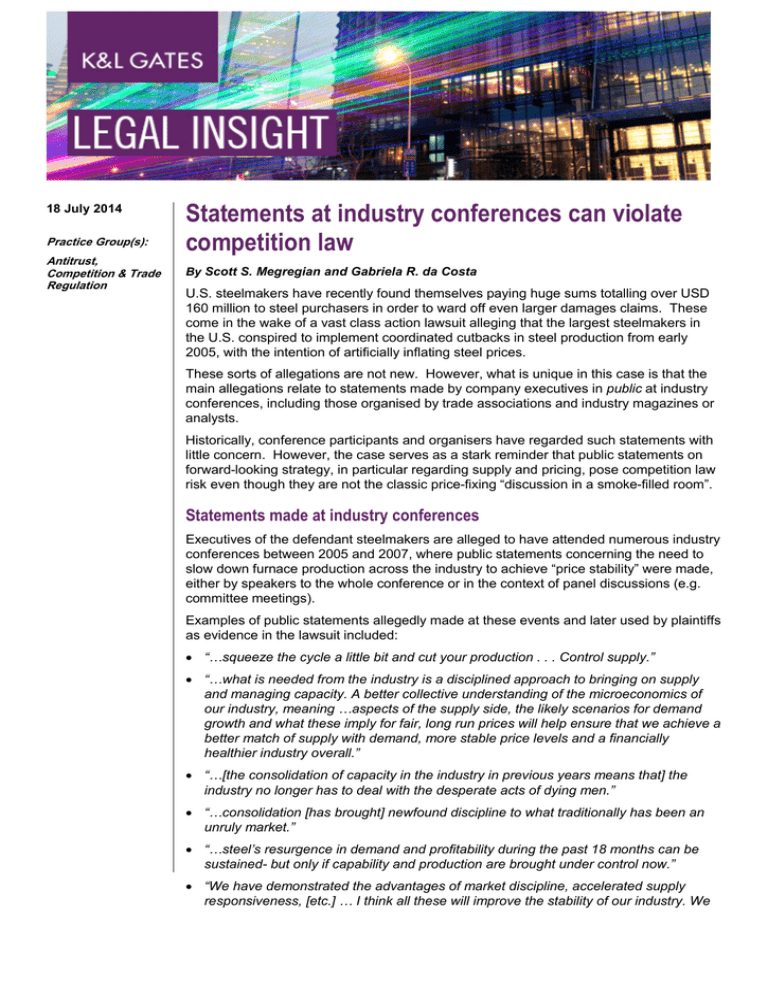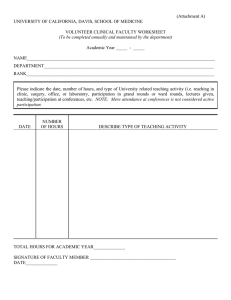
18 July 2014
Practice Group(s):
Antitrust,
Competition & Trade
Regulation
Statements at industry conferences can violate
competition law
By Scott S. Megregian and Gabriela R. da Costa
U.S. steelmakers have recently found themselves paying huge sums totalling over USD
160 million to steel purchasers in order to ward off even larger damages claims. These
come in the wake of a vast class action lawsuit alleging that the largest steelmakers in
the U.S. conspired to implement coordinated cutbacks in steel production from early
2005, with the intention of artificially inflating steel prices.
These sorts of allegations are not new. However, what is unique in this case is that the
main allegations relate to statements made by company executives in public at industry
conferences, including those organised by trade associations and industry magazines or
analysts.
Historically, conference participants and organisers have regarded such statements with
little concern. However, the case serves as a stark reminder that public statements on
forward-looking strategy, in particular regarding supply and pricing, pose competition law
risk even though they are not the classic price-fixing “discussion in a smoke-filled room”.
Statements made at industry conferences
Executives of the defendant steelmakers are alleged to have attended numerous industry
conferences between 2005 and 2007, where public statements concerning the need to
slow down furnace production across the industry to achieve “price stability” were made,
either by speakers to the whole conference or in the context of panel discussions (e.g.
committee meetings).
Examples of public statements allegedly made at these events and later used by plaintiffs
as evidence in the lawsuit included:
• “…squeeze the cycle a little bit and cut your production . . . Control supply.”
• “…what is needed from the industry is a disciplined approach to bringing on supply
and managing capacity. A better collective understanding of the microeconomics of
our industry, meaning …aspects of the supply side, the likely scenarios for demand
growth and what these imply for fair, long run prices will help ensure that we achieve a
better match of supply with demand, more stable price levels and a financially
healthier industry overall.”
• “…[the consolidation of capacity in the industry in previous years means that] the
industry no longer has to deal with the desperate acts of dying men.”
• “…consolidation [has brought] newfound discipline to what traditionally has been an
unruly market.”
• “…steel’s resurgence in demand and profitability during the past 18 months can be
sustained- but only if capability and production are brought under control now.”
• “We have demonstrated the advantages of market discipline, accelerated supply
responsiveness, [etc.] … I think all these will improve the stability of our industry. We
Statements at industry conferences can violate
competition law
can take advantage of the education we have received and learn from it, and will find
that fewer players and tighter metallics will be beneficial for the overall industry.”
•
“…[the] “softening of the market” [is not due] to a “sudden drop in demand” [but
rather] “to an inventory overhang situation created in the market…[this can be dealt
with though] management of the industry’s supply chain.”
• “…[collective action] will lead to companies adjusting production levels to ensure that
the inventory corrects itself and the state of equilibrium is reestablished. Thus if we as
an industry can understand this phenomena we will be able to build more
sustainability in our operations.”
• “…urge production restraint…”
• “…hold the line on capacity…”
• “…take a moment to enjoy. We have successfully made considerable progress in
consolidation. We have successfully demonstrated the benefits that a more
consolidated industry creates. We have successfully demonstrated our ability to better
manage supply and demand.”
• “supply reductions” will “cause a sharp recovery” [in steel prices, particularly
considering] “broad-based underlying demand strength.”
• “…maintain focus on SUPPLY DISCIPLINE.”
• “[I urge you] to adjust [your] production rates so the price of steel doesn’t drop.”
• “[We all] need to work together to keep the prices high regardless of the flexibility in
the marketplace.”
• “…whenever the steel makers are tempted by the market and therefore fluctuate their
prices, the growth of the industry will quickly decline.”
Coordinated conduct following industry conferences
The defendant steelmakers are accused of all implementing coordinated and
unprecedented production cutbacks on at least three separate occasions, within days or
weeks following industry conferences where statements of the above nature were made
or discussed. These cuts were followed by almost immediate price increases.
The cutbacks were implemented despite the defendants’ public projections (made shortly
before the cutbacks) that demand for steel products was expected to remain strong.
The defendants’ behaviour increasingly became the subject of various complaints,
leading among other consequences to the current class action lawsuit filed in the U.S.
courts.
Lessons for conference organisers and participants
Conference hosts and attendees have generally always regarded public statements
made by company executives at industry events, in particular commercially organised
conferences, as not raising competition law concerns.
However, this case is a clear “wake-up call” for all industries that public statements on
forward-looking strategy, such as supply plans or pricing, may give rise to competition
law liability for conference participants (and potentially even organisers) if they result in
coordinated market activity. This is the case even if statements are of a general nature.
2
Statements at industry conferences can violate
competition law
Competition authorities worldwide have increasingly begun to crack down on such
statements because they may reduce uncertainties in the market and thus facilitate the
coordination of competing companies’ behaviour. Other examples of “public signalling”
of future conduct which have recently been found to violate competition law are
considered in this earlier alert.
In view of the above, it is of critical importance that all conference organisers, speakers
and participants be educated on the competition law risks they face, and put in place the
necessary protocols to limit their exposure. Absent such safeguards, companies may
find themselves facing huge fines and lawsuits for behaviour they always regarded as
standard industry practice.
If you have any questions on his topic, please contact us.
Authors:
Scott S. Megregian
scott.megregian@klgates.com
+44.(0)20.7360.8110
Gabriela R. da Costa
gabriela.dacosta@klgates.com
+44.(0)20.7360.8115
Anchorage Austin Beijing Berlin Boston Brisbane Brussels Charleston Charlotte Chicago Dallas Doha Dubai Fort Worth Frankfurt
Harrisburg Hong Kong Houston London Los Angeles Melbourne Miami Milan Moscow Newark New York Orange County Palo Alto
Paris Perth Pittsburgh Portland Raleigh Research Triangle Park San Diego San Francisco São Paulo Seattle Seoul Shanghai
Singapore Spokane Sydney Taipei Tokyo Warsaw Washington, D.C. Wilmington
K&L Gates practices out of 48 fully integrated offices located in the United States, Asia, Australia, Europe, the
Middle East and South America and represents leading global corporations, growth and middle-market
companies, capital markets participants and entrepreneurs in every major industry group as well as public
sector entities, educational institutions, philanthropic organizations and individuals. For more information
about K&L Gates or its locations, practices and registrations, visit www.klgates.com.
This publication is for informational purposes and does not contain or convey legal advice. The information herein should not be used or relied upon
in regard to any particular facts or circumstances without first consulting a lawyer.
© 2014 K&L Gates LLP. All Rights Reserved.
3



![[Today’s Date] [Your Supervisor’s First Name] [Your School or District’s Name]](http://s2.studylib.net/store/data/010451343_1-ed5410b4013e6d3fbc1a9bbd91a926a9-300x300.png)


